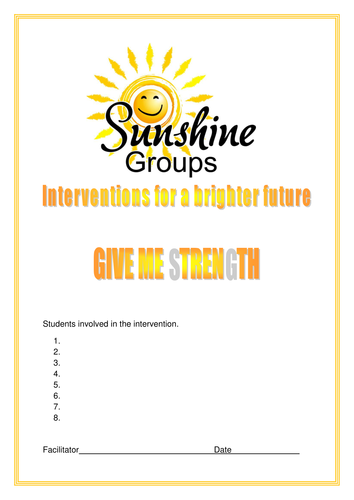


The intervention - is divided up into 7 sessions, covering different aspects of the programme.
The student pack - contains between 19 - 24 worksheets which enable the student to develop skills, log their thoughts and feelings and to form the basis of the discussions.
The facilitator pack - accompanies the student pack contains roughly 35 - 40 pages which support the worksheets, suggesting what to discuss, which issues to cover and how to encourage good debate.
AIMS OF THE INTERVENTION This is an intervention aimed at students who suffer from low confidence, anxiety, phobias and are generally lost in their world. It differs from many of the programmes because it focuses more on them and how they navigate their world; aiming to establish triggers to their behaviour and addressing them giving the student skills and tools to escape from their negative world.
FACILITATOR NOTES These students tend to be unsure of themselves and extremely vulnerable; so managing them through this intervention programme will be a delicate task. They will likely be different sorts of phobia and anxiety etc, but hopefully they will find reassurance and support from their peers and grow in confidence as a result.
REFERRAL CRITERIA
Withdrawn/loner
Expressing fear or anxiety
Cries often
Expresses worthlessness
**This is a difficult one as some of these students ‘hide’ very well and can be highly functioning students apart from certain aspects of their life. I worked with one student who was in the ‘popular’ gang, but who suffered from one of the worst cases of anxiety and phobia I have ever seen. So just bear in mind that some students may ‘act out’ and exhibit different behaviours; he came to my attention because teachers were complaining about him going to the toilet too much (because he was freaking out!) and asking if he needed a toilet pass!!
BASIC OVERVIEW OF THE INTERVENTION SESSIONS
1.How strong am I? - Getting to know you basics, with an emphasis on feelings and emotions.
2.What pushes my buttons? - Seeking out possible negative events and issues which may have influenced the anxiety and phobia.
3.What is my go to response? - Establishing what the ‘normal’ behaviour is and discussing alternatives.
4.What are my triggers? - Looking at what/who may be triggering the situations, feelings and difficulties.
5.How do I want to be? - Continuing the reframing and alternative positive framework for the future.
6.The way forward - Cementing the positives and making plans for future issues.
7.Follow up - General, but ongoing positive focus.
Something went wrong, please try again later.
This resource hasn't been reviewed yet
To ensure quality for our reviews, only customers who have purchased this resource can review it
Report this resourceto let us know if it violates our terms and conditions.
Our customer service team will review your report and will be in touch.